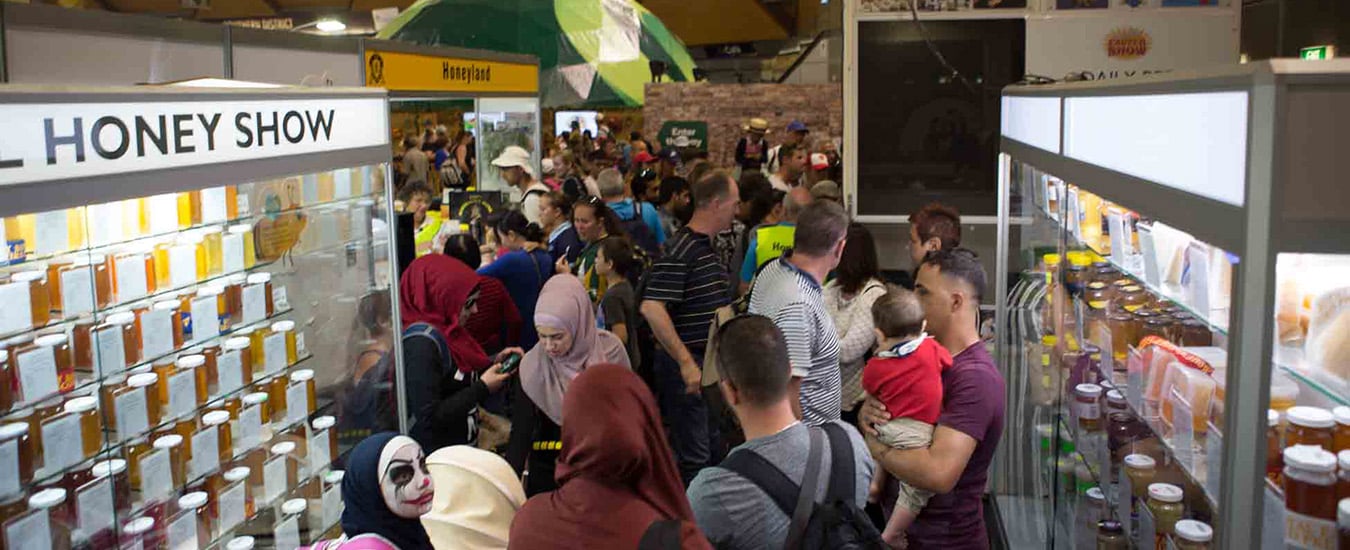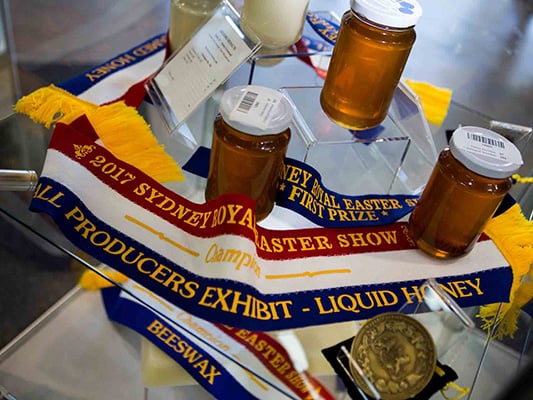Honey shows take place at conferences and agricultural fairs. They are a great way to promote the industry to the public in terms of the quality and variety of Australian honeys.
Comb selection
Select newly drawn white combs with fully capped honey. The combs should be held up with a bright light behind the comb and inspected for pollen and uniformity of colour. Pollen must not be mixed with shown honey and single-floral source honey is optimum.

Honey shows are a great way to showcase the industry to the public and drive up demand for 100% pure Australian honey Source: Emmanuel Farrugia saveourbees.com.au
Extraction
The best method to extract honey for shows is to press the honey from the cells. This is the preferred method as it minimises air entry. Another method is to use a small hand extractor to prevent heating the honey.
Pour the honey down the edge of the settling container to minimise air bubbles and ensure that the lid is air tight to prevent moisture absorption. Allow the honey to settle for several days at 37oC. This will cause any air bubbles, wax or other material to rise to the surface where it can be carefully skimmed off.
Straining
The honey should be at approximately 37oC. Filter the honey using a cone-shaped nylon or muslin straining bag. Have the point of the strainer almost touching the bottom of the container. Keep the strained honey in this container for about one week.
Filling the jars
Ensure your jars meet the requirements of the show. Hold them up to the light to ensure that there are no flaws in the glass. Clean and polish the jars before filling. Pour the honey down the inside edge of the jar to minimise air bubbles. Fill such that the jar is full but the honey does not touch the inside of the cap. Store the jars upright in a dark location to prevent colour change. All jars in the same entry should be of the same blend or floral type.
Honey judging

The best of the best
Source: Emmanuel Farrugia saveourbees.com.au
Flavour: Honey should be palatable and free from the ‘tang’ of fermentation and acidity. It must be characteristic of the floral honey type. Points for flavour depend on the palate of the judge.
Density: Higher density honey is considered superior. Density can be determined with a refractometer or rating the rising of the air bubble when inverting the jar.
Colour: There are various categories ranging from light to dark. A honey grader can be used to ascertain which class the honey belongs to.
Aroma: Aroma varies according to the floral source. Honeys with offensive aroma due to floral source, fermentation or over-heating lose points.
Clearness: Honey must not have a dull or cloudy appearance, it should be clean and have a sparkle about it. Particles are indicative of poor filtering.
Brightness: Slightly warm the jars before showing to increase the brightness and remove minute crystals if present. However, the honey must be at room temperature for judging.
Video
Bruce White, an international honey judge, goes through the process of honey judging.
Further information:
- Video: Len Verrenkamp provides tips for showing honey and other bee products at the Tocal Beekeepers field day in 2019.
Acknowledgements:
- R Owen (2015) The Australian Beekeeping Manual. Exisle Publishing, Wollombi NSW, Australia
- This article was peer-reviewed by Nadine Chapman and Elizabeth Frost.


